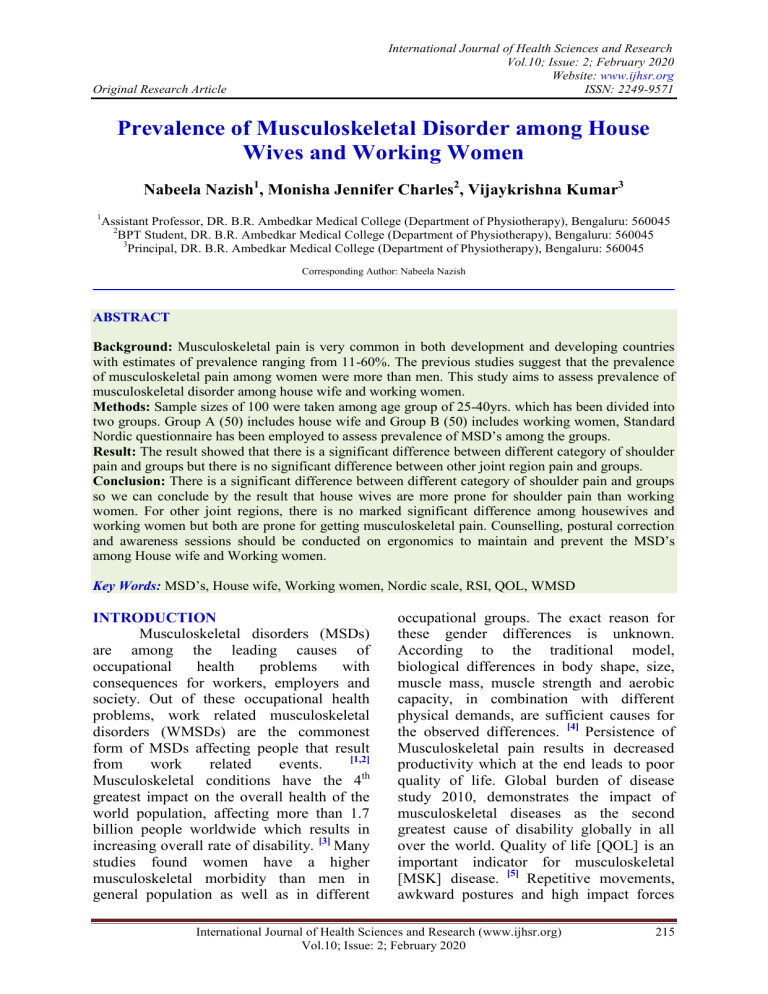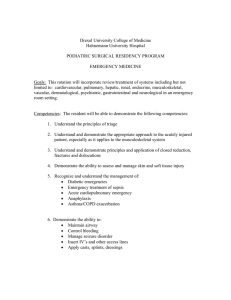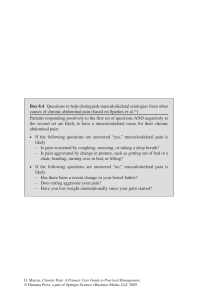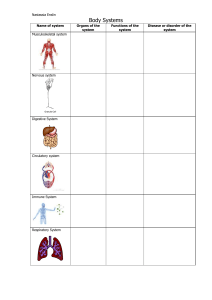
International Journal of Health Sciences and Research Vol.10; Issue: 2; February 2020 Website: www.ijhsr.org ISSN: 2249-9571 Original Research Article Prevalence of Musculoskeletal Disorder among House Wives and Working Women Nabeela Nazish1, Monisha Jennifer Charles2, Vijaykrishna Kumar3 1 Assistant Professor, DR. B.R. Ambedkar Medical College (Department of Physiotherapy), Bengaluru: 560045 2 BPT Student, DR. B.R. Ambedkar Medical College (Department of Physiotherapy), Bengaluru: 560045 3 Principal, DR. B.R. Ambedkar Medical College (Department of Physiotherapy), Bengaluru: 560045 Corresponding Author: Nabeela Nazish ABSTRACT Background: Musculoskeletal pain is very common in both development and developing countries with estimates of prevalence ranging from 11-60%. The previous studies suggest that the prevalence of musculoskeletal pain among women were more than men. This study aims to assess prevalence of musculoskeletal disorder among house wife and working women. Methods: Sample sizes of 100 were taken among age group of 25-40yrs. which has been divided into two groups. Group A (50) includes house wife and Group B (50) includes working women, Standard Nordic questionnaire has been employed to assess prevalence of MSD’s among the groups. Result: The result showed that there is a significant difference between different category of shoulder pain and groups but there is no significant difference between other joint region pain and groups. Conclusion: There is a significant difference between different category of shoulder pain and groups so we can conclude by the result that house wives are more prone for shoulder pain than working women. For other joint regions, there is no marked significant difference among housewives and working women but both are prone for getting musculoskeletal pain. Counselling, postural correction and awareness sessions should be conducted on ergonomics to maintain and prevent the MSD’s among House wife and Working women. Key Words: MSD’s, House wife, Working women, Nordic scale, RSI, QOL, WMSD INTRODUCTION Musculoskeletal disorders (MSDs) are among the leading causes of occupational health problems with consequences for workers, employers and society. Out of these occupational health problems, work related musculoskeletal disorders (WMSDs) are the commonest form of MSDs affecting people that result [1,2] from work related events. Musculoskeletal conditions have the 4th greatest impact on the overall health of the world population, affecting more than 1.7 billion people worldwide which results in increasing overall rate of disability. [3] Many studies found women have a higher musculoskeletal morbidity than men in general population as well as in different occupational groups. The exact reason for these gender differences is unknown. According to the traditional model, biological differences in body shape, size, muscle mass, muscle strength and aerobic capacity, in combination with different physical demands, are sufficient causes for the observed differences. [4] Persistence of Musculoskeletal pain results in decreased productivity which at the end leads to poor quality of life. Global burden of disease study 2010, demonstrates the impact of musculoskeletal diseases as the second greatest cause of disability globally in all over the world. Quality of life [QOL] is an important indicator for musculoskeletal [MSK] disease. [5] Repetitive movements, awkward postures and high impact forces International Journal of Health Sciences and Research (www.ijhsr.org) Vol.10; Issue: 2; February 2020 215 Nabeela Nazish et.al. Prevalence of musculoskeletal disorder among house wives and working women are the three primary risk factors for WRMSD’s. The WRMSD’s developed due to exposure of above factors over a longer period of time that need suitable coping strategies which will help in controlling it. Workers performing strenuous work for longer duration can cope with musculoskeletal symptoms by modifying their working techniques with the help of ergonomic principles. [6] Considering different factors that affect women’s health are lack of coordination in shared responsibility of men, women and family, considering women’s employment as a minor role alongside the major of housekeeping, and to define the problem and its relationship to work factors, increasing interest has been directed in many countries to the development of various methods to estimate and record musculoskeletal symptoms. Questionnaire has proved to be the most obvious means of collecting the necessary data. [7] Hence, this study was undertaken for finding the prevalence of musculoskeletal disorder among house wife verses working women using Nordic scale. METHODOLOGY Sample Design: Convenient sampling Sample Size: Sample sizes of 100 subjects were taken among the age group of 25-40 yrs which has been divided into two groups. Group A (50) includes house wives and Group B (50) includes working women Criteria For Selection Inclusion Criteria 1. Age 25-35 years 2. Married women with primigravida 3. No pregnancy at the time of survey Exclusion Criteria Any diagnosed case of musculoskeletal/ neurological/ Psychological/ psychiatric / dermatological/ deficit or disorders that can affect the study Procedure Sample of 100 subjects were taken among the age group of 25-40 yrs which has been divided into two groups. Group A (50) includes house wives and Group B (50) includes working women. Then the purpose and procedure of the test was explained to all the subjects and consent was taken. Standard Nordic questionnaire has been employed to access prevalence of MSDs among these two groups. This Sample, general questionnaire, recognized/ validated internationally, detects symptoms in neck, back, shoulder and extremities. It presents 28 multiple choice questions, sometimes negative, structured in two well differentiated parts. The first part, the general one refers to symptoms in 9 parts of the body [Neck, Shoulders, Elbows, Wrist/ Hands, Upper Back, Lower Back, Hip/ Thighs, Knees & Ankles / Feet] during the last 12 months / 7 days. The second part, the specific one, refers to symptoms in 3 parts of the body [Neck, Shoulders & Lower Back] throughout the subjects working life/ 7days beforehand. In both cases, complementary information of the worker would be helpful, but not obligatory, to ensure a better evaluation. RESULTS Total of 100 women participated in the study which was divided into two groups. Group A (50) has house wives and Group B (50) has working women. Nordic questionnaire was used as an outcome measure. It indicates the body region calculated on the basis of last 7 days,12 months and functional impairment questionnaire formatting in Yes and No percentage. Statistical Analysis was done by using chi square test. The chi square test is used to find the association between the tributes. Among the two groups that is Group A and Group B the chi square test is significant if the p value is less than 0.05.Our result showed that there is a significant difference between different category of shoulder pain and groups but there is no significant difference between other joint region pain and groups. International Journal of Health Sciences and Research (www.ijhsr.org) Vol.10; Issue: 2; February 2020 216 Nabeela Nazish et.al. Prevalence of musculoskeletal disorder among house wives and working women Cross tabulation of neck12m N Y Total Chi square =.040 Count % within GROUP Count % within GROUP Count % within GROUP p-value=0.841 ns GROUP HOUSE WIFE 24 48.0% 26 52.0% 50 100.0% Total WORKING WOMEN 25 50.0% 25 50.0% 50 100.0% 49 49.0% 51 51.0% 100 100.0% Cross tabulation of neck7d GROUP HOUSE WIFE b N Count 23 % within GROUP 46.0% Y Count 27 % within GROUP 54.0% Total Count 50 % within GROUP 100.0% Chi square =.160 p-value=0.689 ns Total WORKING WOMEN 25 50.0% 25 50.0% 50 100.0% 48 48.0% 52 52.0% 100 100.0% Cross tabulation of neckFI12m GROUP HOUSE WIFE c N Count 24 % within GROUP 48.0% Y Count 26 % within GROUP 52.0% Total Count 50 % within GROUP 100.0% Chi square =.040 p-value=0.841 ns Total WORKING WOMEN 25 50.0% 25 50.0% 50 100.0% 49 49.0% 51 51.0% 100 100.0% Cross tabulation of soulder12m GROUP HOUSE WIFE d N Count 19 % within GROUP 38.0% Y Count 31 % within GROUP 62.0% Total Count 50 % within GROUP 100.0% Chi square 6.763 p-value=0.009 sig Total WORKING WOMEN 32 64.0% 18 36.0% 50 100.0% 51 51.0% 49 49.0% 100 100.0% Cross tabulation of soulder7d GROUP HOUSE WIFE e N Count 19 % within GROUP 38.0% Y Count 31 % within GROUP 62.0% Total Count 50 % within GROUP 100.0% Chi square 6.763 p-value=0.009 sig Cross tabulation of soulderFI12m GROUP HOUSE WIFE f N Count 20 % within GROUP 40.0% Y Count 30 % within GROUP 60.0% Total Count 50 % within GROUP 100.0% Chi square 5.769 p-value=0.016 sig Total WORKING WOMEN 32 64.0% 18 36.0% 50 100.0% 51 51.0% 49 49.0% 100 100.0% Total WORKING WOMEN 32 64.0% 18 36.0% 50 100.0% 52 52.0% 48 48.0% 100 100.0% International Journal of Health Sciences and Research (www.ijhsr.org) Vol.10; Issue: 2; February 2020 217 Nabeela Nazish et.al. Prevalence of musculoskeletal disorder among house wives and working women Cross tabulation of elbow12m GROUP HOUSE WIFE g N Count 47 % within GROUP 94.0% Y Count 3 % within GROUP 6.0% Total Count 50 % within GROUP 100.0% Chi square =2.554 p-value=0.111 ns Total WORKING WOMEN 42 84.0% 8 16.0% 50 100.0% 89 89.0% 11 11.0% 100 100.0% Cross tabulation of elbow7d GROUP HOUSE WIFE h N Count 47 % within GROUP 94.0% Y Count 3 % within GROUP 6.0% Total Count 50 % within GROUP 100.0% Chi square =2.554 p-value=0.111 ns Total WORKING WOMEN 42 84.0% 8 16.0% 50 100.0% 89 89.0% 11 11.0% 100 100.0% Cross tabulation of elbowFI12m GROUP HOUSE WIFE i N Count 47 % within GROUP 94.0% Y Count 3 % within GROUP 6.0% Total Count 50 % within GROUP 100.0% Chi square =2.554 p-value=0.111 ns Total WORKING WOMEN 42 84.0% 8 16.0% 50 100.0% 89 89.0% 11 11.0% 100 100.0% Cross tabulation of WH12m GROUP HOUSE WIFE j N Count 40 % within GROUP 80.0% Y Count 10 % within GROUP 20.0% Total Count 50 % within GROUP 100.0% Chi square =1.961 p-value=0.161 ns Total WORKING WOMEN 45 90.0% 5 10.0% 50 100.0% 85 85.0% 15 15.0% 100 100.0% Cross tabulation of WH12d GROUP HOUSE WIFE k N Count 40 % within GROUP 80.0% Y Count 10 % within GROUP 20.0% Total Count 50 % within GROUP 100.0% Chi square =1.961 p-value=0.161 ns Total WORKING WOMEN 45 90.0% 5 10.0% 50 100.0% 85 85.0% 15 15.0% 100 100.0% Cross tabulation of WHFI12m GROUP HOUSE WIFE l N Count 40 % within GROUP 80.0% Y Count 10 % within GROUP 20.0% Total Count 50 % within GROUP 100.0% Chi square =1.961 p-value=0.161 ns Total WORKING WOMEN 45 90.0% 5 10.0% 50 100.0% 85 85.0% 15 15.0% 100 100.0% International Journal of Health Sciences and Research (www.ijhsr.org) Vol.10; Issue: 2; February 2020 218 Nabeela Nazish et.al. Prevalence of musculoskeletal disorder among house wives and working women Cross tabulation of back12m GROUP HOUSE WIFE m N Count 10 % within GROUP 20.0% Y Count 40 % within GROUP 80.0% Total Count 50 % within GROUP 100.0% Chi square =.065 p-value=0.799 ns Total WORKING WOMEN 9 18.0% 41 82.0% 50 100.0% 19 19.0% 81 81.0% 100 100.0% Cross tabulation of back7d GROUP HOUSE WIFE n N Count 10 % within GROUP 20.0% Y Count 40 % within GROUP 80.0% Total Count 50 % within GROUP 100.0% Chi square =.065 p-value=0.799 ns Total WORKING WOMEN 9 18.0% 41 82.0% 50 100.0% 19 19.0% 81 81.0% 100 100.0% Cross tabulation of backFI 12m GROUP HOUSE WIFE o N Count 10 % within GROUP 20.0% Y Count 40 % within GROUP 80.0% Total Count 50 % within GROUP 100.0% Chi square =.065 p-value=0.799 ns Total WORKING WOMEN 9 18.0% 41 82.0% 50 100.0% 19 19.0% 81 81.0% 100 100.0% Cross tabulation of HTB12m GROUP HOUSE WIFE p N Count 29 % within GROUP 58.0% Y Count 21 % within GROUP 42.0% Total Count 50 % within GROUP 100.0% Chi square =.000 p-value=1 ns Total WORKING WOMEN 29 58.0% 21 42.0% 50 100.0% 58 58.0% 42 42.0% 100 100.0% Cross tabulation of HTB 7d GROUP HOUSE WIFE q N Count 29 % within GROUP 58.0% Y Count 21 % within GROUP 42.0% Total Count 50 % within GROUP 100.0% Chi square =.000 p-value=1 ns Total WORKING WOMEN 29 58.0% 21 42.0% 50 100.0% 58 58.0% 42 42.0% 100 100.0% Cross tabulation of HTBFI12m GROUP HOUSE WIFE r N Count 30 % within GROUP 60.0% Y Count 20 % within GROUP 40.0% Total Count 50 % within GROUP 100.0% Chi square =.041 p-value=0.839 ns Total WORKING WOMEN 29 58.0% 21 42.0% 50 100.0% 59 59.0% 41 41.0% 100 100.0% International Journal of Health Sciences and Research (www.ijhsr.org) Vol.10; Issue: 2; February 2020 219 Nabeela Nazish et.al. Prevalence of musculoskeletal disorder among house wives and working women Cross tabulation of knee12m GROUP HOUSE WIFE s N Count 34 % within GROUP 68.0% Y Count 16 % within GROUP 32.0% Total Count 50 % within GROUP 100.0% Chi square =1.268 p-value=0.266 ns Total WORKING WOMEN 39 78.0% 11 22.0% 50 100.0% 73 73.0% 27 27.0% 100 100.0% Cross tabulation of knee7d GROUP HOUSE WIFE t N Count 34 % within GROUP 68.0% Y Count 16 % within GROUP 32.0% Total Count 50 % within GROUP 100.0% Chi square =1.871 p-value=0.171 ns Total WORKING WOMEN 40 80.0% 10 20.0% 50 100.0% 74 74.0% 26 26.0% 100 100.0% Cross tabulation of kneeFI12m GROUP HOUSE WIFE u N Count 35 % within GROUP 70.0% Y Count 15 % within GROUP 30.0% Total Count 50 % within GROUP 100.0% Chi square =1.333 p-value=0.248 ns Cross tabulation of anklefeet12m GROUP HOUSE WIFE v N Count 35 % within GROUP 70.0% Y Count 15 % within GROUP 30.0% Total Count 50 % within GROUP 100.0% Chi square =.457 p-value=0.499 ns Total WORKING WOMEN 40 80.0% 10 20.0% 50 100.0% 75 75.0% 25 25.0% 100 100.0% Total WORKING WOMEN 38 76.0% 12 24.0% 50 100.0% 73 73.0% 27 27.0% 100 100.0% Cross tabulation of anklefeet7d GROUP HOUSE WIFE w N Count 36 % within GROUP 72.0% Y Count 14 % within GROUP 28.0% Total Count 50 % within GROUP 100.0% Chi square =.208 p-value=0.648 ns Cross tabulation of anklefeetFI12m GROUP HOUSE WIFE x N Count 35 % within GROUP 70.0% Y Count 15 % within GROUP 30.0% Total Count 50 % within GROUP 100.0% Chi square =.457 p-value=0.499 ns DISCUSSION The present study was aimed to analyse the prevalence of musculoskeletal Total WORKING WOMEN 38 76.0% 12 24.0% 50 100.0% 74 74.0% 26 26.0% 100 100.0% Total WORKING WOMEN 38 76.0% 12 24.0% 50 100.0% 73 73.0% 27 27.0% 100 100.0% disorder among House wife and Working women. The responses of 100 participants were compared between both the groups. International Journal of Health Sciences and Research (www.ijhsr.org) Vol.10; Issue: 2; February 2020 220 Nabeela Nazish et.al. Prevalence of musculoskeletal disorder among house wives and working women The respondents were affected by MSD’s in one or more body regions. The prevalence of comparing MSD’s among Housewife and Working women result in high risk due to the negligence of symptoms present in the early stage leading to repetitive stress injuries (RSI) and later stage leading to MSD’s. Our study showed that house wives are more prone for shoulder pain than working women. The high prevalence of MSD’s among house wife suggests that house work could be an independent risk factor contributing to the development of musculoskeletal disorder among women. Other reasons for this result could be due to some altered essential biomechanical parameter and some basic features of house work such as child care, care giving, household chores, food preparation, cleaning, that results in developing bad postures and strain on musculoskeletal structures. (SumitKalra, Barkha Bhatnagar ,2015).According to the study ,Working women are also prone to MSD’s due to the multi tasks they perform in the daily life because of static posture for longer period of time with more number of working hours, stress, sleep disturbance and followed by the routine house hold activities, which leads to physical and psychological stress. The results are in accordance with study done by Deepti Shettar, Mayur S. Sherkhane in the year 2017 in assessment of risk factors of MSD’s among working women. [2] Awareness of proper movement analysis according to ergonomics should be educated to avoid MSD’s among women to indicate opportunities for prevention. [8] CONCLUSION It can be concluded from the present study that selected Housewife and Working women were having MSD’s in one or more body region last 12 months and last 7 days. Our study showed that house wives are more prone for shoulder pain than working women. For other joint regions, there is no marked significant difference among housewives and working women but both are prone for getting musculoskeletal pain. Nordic Questionnaire were used as an assessment tool that can be recommended and utilized commonly as a screening tool among House wife and Working women which can detect MSD’s at an early stage. Counselling, postural correction and awareness sessions should be conducted on Ergonomics to maintain and prevent the MSD’s among House wife and Working women. REFERENCES 1. Kalra S, Bhatnagar B. Prevalence of musculoskeletal disorder among housewives, International Research Journal of Engineering and Technology (IRJET) e-ISSN: 2395 -0056 Volume: 04 Issue: 05 | May -2017 2. Shettar D, Sherkhane MS. Assessment of risk factors for the development of musculoskeletal disorders among working women. International Journal Of Community Medicine And Public Health. 2017 Feb 22;4(3):718-23. 3. V Bihari,C Kesavachandranetal, Musculoskeletal pain and its associated risk factors in residents of national capital region IJOEM:15:2 May – August 2011 4. Punnett L, Wegman DH. Work-related musculoskeletal disorders: the epidemiologic evidence and the debate. Journal of electromyography and kinesiology. 2004 Feb 1;14(1):13-23. 5. Harriet B, Sen Presser G. Women’s empowerment and demographic processes,31st august,2000. 6. Fazli B, Ansari H, Noorani M, Jafari SM, Sharifpoor Z, Ansari S. The prevalence of musculoskeletal disorders and its predictors among Iranians’ Housewives. International journal of epidemiologic research. 2016;3(1):5362. 7. Tinubu BM, Mbada CE, Oyeyemi AL, Fabunmi AA. Work-related musculoskeletal disorders among nurses in Ibadan, South-west Nigeria: a crosssectional survey. BMC Musculoskeletal disorders. 2010 Dec;11(1):12. International Journal of Health Sciences and Research (www.ijhsr.org) Vol.10; Issue: 2; February 2020 221 Nabeela Nazish et.al. Prevalence of musculoskeletal disorder among house wives and working women 8. Loghmani A, Golshiri P, Zamani A, KheirmandM, Jafari N. Musculoskeletal symptoms and job satisfaction among office-workers: a cross-sectional study from Iran. Acta medica academica. 2013 May 17;42(1):46-54. How to cite this article: Nazish N, Charles MJ, Kumar V. Prevalence of musculoskeletal disorder among house wives and working women. Int J Health Sci Res. 2020; 10(2):215222. ****** International Journal of Health Sciences and Research (www.ijhsr.org) Vol.10; Issue: 2; February 2020 222


